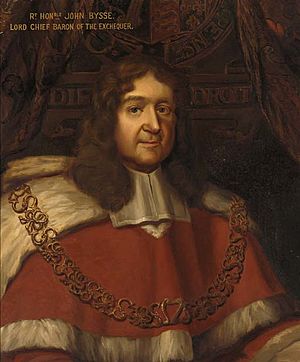John Bysse facts for kids
Quick facts for kids
John Bysse
|
|
|---|---|

Portrait by James Thornhill
|
|
| Born | c.1602 |
| Died | 1680 Dublin
|
| Occupation | Judge |
| Known for | member of the Parliament of Ireland Recorder of Dublin Chief Baron of the Irish Exchequer |
John Bysse (born around 1602, died 1680) was an important figure in Irish law and politics. He served in the Parliament of Ireland in the 1630s and 1640s. For a time, he was not allowed to hold public office. However, after King Charles II returned to power, John Bysse became one of Ireland's most senior judges.
Contents
John Bysse's Early Life and Education
John Bysse was born around the year 1602. He was the oldest son of Christopher Bysse. Christopher worked for the government in a department called the Exchequer. John's grandfather, Robert Bysse, also worked there. John's mother was Margaret Forster, whose father was an important city official in Dublin.
John had a brother named Robert and a sister named Elinor. Elinor later married William Ball, who was also a member of Parliament. John Bysse studied at Trinity College, Dublin. In 1632, he became a member of the King's Inns, which is a place where lawyers are trained.
Political Career and Public Service
In 1634, John Bysse was chosen to be a member of the Irish House of Commons. He represented the area of Charlemont. In the same year, he also became the Recorder of Dublin. This was an important legal job, like a chief judge for the city. He was chosen again for the House of Commons in 1640.
Role During the Irish Rebellion
When the Irish Rebellion of 1641 began, John Bysse and his brother Robert were leaders. They were part of the group in Parliament that supported the King. This group was called the royalists. They worked with other royalist groups to oppose the forces of Oliver Cromwell later on.
Life During the Commonwealth Period
During the time known as the Commonwealth, John Bysse continued to be the Recorder of Dublin. He was even suggested for a position on the High Court. He was also elected to the Parliament that governed during this time, representing Dublin city. However, he was not allowed to take his seat.
Even though he strongly supported the King, John Bysse was willing to consider Oliver Cromwell becoming King for a short time. This shows he was practical.
Return to Power After the Restoration
When King Charles II returned to power in 1660, it was called the Restoration. John Bysse was then appointed as the Chief Baron of the Irish Exchequer. This was a very high judicial position. He held this job until he died. Besides being a judge, he also regularly advised the Irish House of Lords on legal matters. He was buried in St. Audoen's Church in Dublin.
Land and Property
John Bysse became a wealthy landowner. He inherited a property called Preston's Inn in Dublin. He built a large house there, which was later taken down in the 1760s. He also owned land near Swords called Brackenstown, which his father had bought. Later, he was given more land in Philipstown (now Daingean) in County Offaly. His family also had an estate near Castleknock.
Personality and Reputation
John Bysse was very well-qualified for his important role as Chief Baron. He had been the Recorder of Dublin for 25 years and had served in Parliament twice. He was known for being hard-working and careful in his duties. People from different political groups generally liked him.
He was also known for being open-minded about religion for his time. In 1665, he caused a bit of a stir when he attended the funeral of a Protestant clergyman who did not follow the main church. This showed his tolerance.
Challenges and Support
After a few years as Chief Baron, some people started to complain. They said he was slow and not as good at his job as he used to be. Some even suggested he was getting too old. It was also said that another judge, Sir Richard Kennedy, was doing a lot of Bysse's work. Because of this, Kennedy received a pay raise.
These complaints were taken seriously. In 1669 and 1671, John Bysse was even threatened with losing his job. However, he was lucky to have a good friend in the Lord Lieutenant, James, Duke of Ormonde. Ormonde was very loyal to his friends. He strongly defended Bysse, saying that while he might be slow, he was honest and worked hard. Ormonde denied that Bysse's mental abilities had declined.
These arguments helped Bysse keep his job. Even though Ormonde later suggested it might be time for Bysse to retire, John Bysse remained Chief Baron until he died in 1680. He was about 78 years old.
Family Life
John Bysse married Margaret Edgeworth, who died in 1676. Margaret's father, Francis Edgeworth, also held an important government position. Margaret was also related to the famous novelist Maria Edgeworth.
John and Margaret had many children who sadly died young. However, they had two daughters who survived:
- Judith: She married Robert Molesworth first. They had a son named Robert, who became the 1st Viscount Molesworth. After Robert died, Judith married Sir William Tichborne. They had several more children, including Henry Tichborne, 1st Baron Ferrard.
- Catherine: She died in 1664. Catherine married the politician Sir Richard Bulkeley, 1st Baronet. They had children, including Sir Richard Bulkeley, 2nd Baronet.

